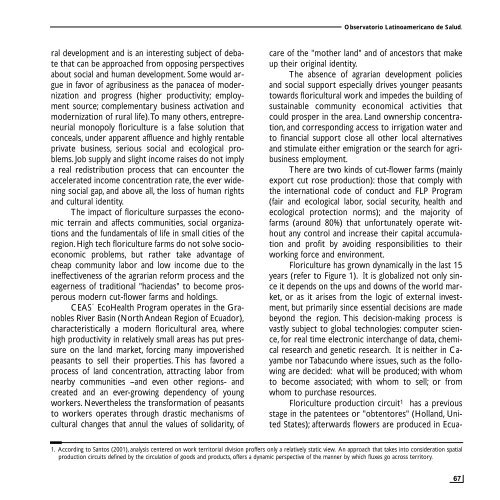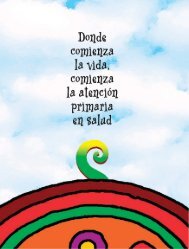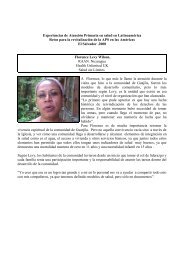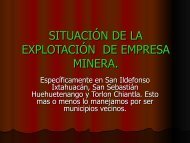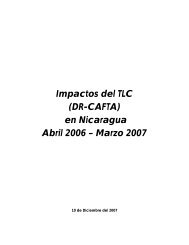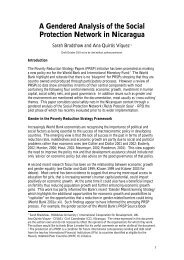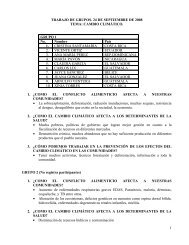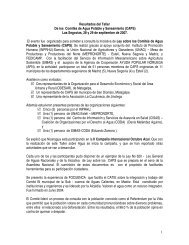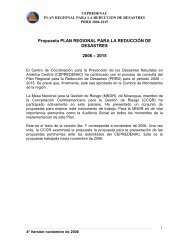Download - CISAS | Centro de Información y Servicios de AsesorÃa ...
Download - CISAS | Centro de Información y Servicios de AsesorÃa ...
Download - CISAS | Centro de Información y Servicios de AsesorÃa ...
Create successful ePaper yourself
Turn your PDF publications into a flip-book with our unique Google optimized e-Paper software.
Observatorio Latinoamericano <strong>de</strong> Salud.ral <strong>de</strong>velopment and is an interesting subject of <strong>de</strong>batethat can be approached from opposing perspectivesabout social and human <strong>de</strong>velopment. Some would arguein favor of agribusiness as the panacea of mo<strong>de</strong>rnizationand progress (higher productivity; employmentsource; complementary business activation andmo<strong>de</strong>rnization of rural life).To many others, entrepreneurialmonopoly floriculture is a false solution thatconceals, un<strong>de</strong>r apparent affluence and highly rentableprivate business, serious social and ecological problems.Job supply and slight income raises do not implya real redistribution process that can encounter theaccelerated income concentration rate, the ever wi<strong>de</strong>ningsocial gap, and above all, the loss of human rightsand cultural i<strong>de</strong>ntity.The impact of floriculture surpasses the economicterrain and affects communities, social organizationsand the fundamentals of life in small cities of theregion. High tech floriculture farms do not solve socioeconomicproblems, but rather take advantage ofcheap community labor and low income due to theineffectiveness of the agrarian reform process and theeagerness of traditional "haciendas" to become prosperousmo<strong>de</strong>rn cut-flower farms and holdings.CEAS´ EcoHealth Program operates in the GranoblesRiver Basin (North An<strong>de</strong>an Region of Ecuador),characteristically a mo<strong>de</strong>rn floricultural area, wherehigh productivity in relatively small areas has put pressureon the land market, forcing many impoverishedpeasants to sell their properties. This has favored aprocess of land concentration, attracting labor fromnearby communities –and even other regions- andcreated and an ever-growing <strong>de</strong>pen<strong>de</strong>ncy of youngworkers. Nevertheless the transformation of peasantsto workers operates through drastic mechanisms ofcultural changes that annul the values of solidarity, ofcare of the "mother land" and of ancestors that makeup their original i<strong>de</strong>ntity.The absence of agrarian <strong>de</strong>velopment policiesand social support especially drives younger peasantstowards floricultural work and impe<strong>de</strong>s the building ofsustainable community economical activities thatcould prosper in the area. Land ownership concentration,and corresponding access to irrigation water andto financial support close all other local alternativesand stimulate either emigration or the search for agribusinessemployment.There are two kinds of cut-flower farms (mainlyexport cut rose production): those that comply withthe international co<strong>de</strong> of conduct and FLP Program(fair and ecological labor, social security, health an<strong>de</strong>cological protection norms); and the majority offarms (around 80%) that unfortunately operate withoutany control and increase their capital accumulationand profit by avoiding responsibilities to theirworking force and environment.Floriculture has grown dynamically in the last 15years (refer to Figure 1). It is globalized not only sinceit <strong>de</strong>pends on the ups and downs of the world market,or as it arises from the logic of external investment,but primarily since essential <strong>de</strong>cisions are ma<strong>de</strong>beyond the region. This <strong>de</strong>cision-making process isvastly subject to global technologies: computer science,for real time electronic interchange of data, chemicalresearch and genetic research. It is neither in Cayambenor Tabacundo where issues, such as the followingare <strong>de</strong>ci<strong>de</strong>d: what will be produced; with whomto become associated; with whom to sell; or fromwhom to purchase resources.Floriculture production circuit 1 has a previousstage in the patentees or "obtentores" (Holland, UnitedStates); afterwards flowers are produced in Ecua-1. According to Santos (2001), analysis centered on work territorial division proffers only a relatively static view. An approach that takes into consi<strong>de</strong>ration spatialproduction circuits <strong>de</strong>fined by the circulation of goods and products, offers a dynamic perspective of the manner by which fluxes go across territory.67


